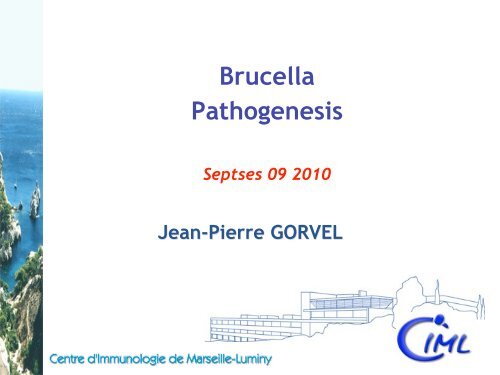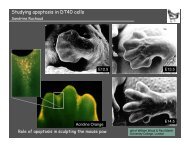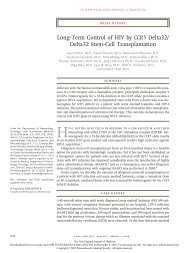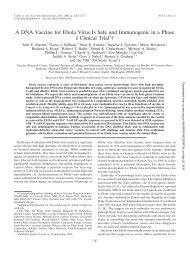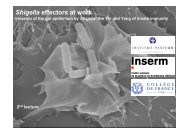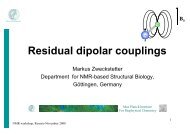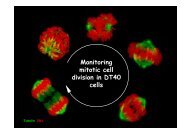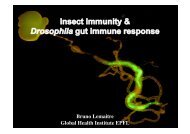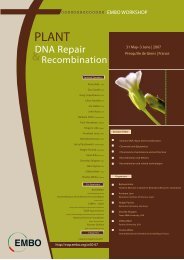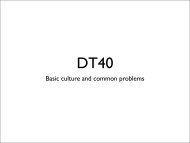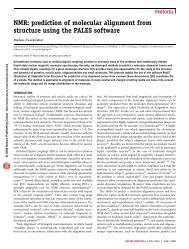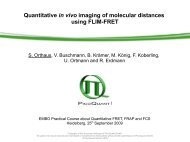You also want an ePaper? Increase the reach of your titles
YUMPU automatically turns print PDFs into web optimized ePapers that Google loves.
<strong>Brucella</strong><br />
Pathogenesis<br />
Septses 09 2010<br />
Jean-Pierre GORVEL
ISOLATION OF BRUCELLAE
ISOLATION OF BRUCELLAE<br />
19 th Century (1860) first description of disease by<br />
Marston
ISOLATION OF BRUCELLAE<br />
19 th Century (1860) first description of disease by<br />
Marston<br />
B.melitensis 1887 (Bruce - Carruana-Secluna)
ISOLATION OF BRUCELLAE<br />
19 th Century (1860) first description of disease by<br />
Marston<br />
B.melitensis 1887 (Bruce - Carruana-Secluna)<br />
B.abortus 1895 (Bang)
ISOLATION OF BRUCELLAE<br />
19 th Century (1860) first description of disease by<br />
Marston<br />
B.melitensis 1887 (Bruce - Carruana-Secluna)<br />
B.abortus 1895 (Bang)<br />
B.suis 1914 (Traun)
ISOLATION OF BRUCELLAE<br />
19 th Century (1860) first description of disease by<br />
Marston<br />
B.melitensis 1887 (Bruce - Carruana-Secluna)<br />
B.abortus 1895 (Bang)<br />
B.suis 1914 (Traun)<br />
B.ovis 1953 (Buddle and Boyes)
ISOLATION OF BRUCELLAE<br />
19 th Century (1860) first description of disease by<br />
Marston<br />
B.melitensis 1887 (Bruce - Carruana-Secluna)<br />
B.abortus 1895 (Bang)<br />
B.suis 1914 (Traun)<br />
B.ovis 1953 (Buddle and Boyes)<br />
B.canis 1966 (Carmichael)
ISOLATION OF BRUCELLAE<br />
19 th Century (1860) first description of disease by<br />
Marston<br />
B.melitensis 1887 (Bruce - Carruana-Secluna)<br />
B.abortus 1895 (Bang)<br />
B.suis 1914 (Traun)<br />
B.ovis 1953 (Buddle and Boyes)<br />
B.canis 1966 (Carmichael)<br />
B.neotomae 1957 (Stoenner and Zackman)
ISOLATION OF BRUCELLAE<br />
19 th Century (1860) first description of disease by<br />
Marston<br />
B.melitensis 1887 (Bruce - Carruana-Secluna)<br />
B.abortus 1895 (Bang)<br />
B.suis 1914 (Traun)<br />
B.ovis 1953 (Buddle and Boyes)<br />
B.canis 1966 (Carmichael)<br />
B.neotomae 1957 (Stoenner and Zackman)<br />
B.cetaceae and B.pinnipediae in marine mammals 1994
HUMAN PATHOGENS
HUMAN PATHOGENS<br />
B.melitensis
HUMAN PATHOGENS<br />
B.melitensis<br />
B.abortus
HUMAN PATHOGENS<br />
B.melitensis<br />
B.abortus<br />
B.suis (except biovar 2)
HUMAN PATHOGENS<br />
B.melitensis<br />
B.abortus<br />
B.suis (except biovar 2)<br />
B.canis
HUMAN PATHOGENS<br />
B.melitensis<br />
B.abortus<br />
B.suis (except biovar 2)<br />
B.canis
HUMAN PATHOGENS<br />
B.melitensis<br />
B.abortus<br />
B.suis (except biovar 2)<br />
B.canis<br />
Human infection due to B.cetaceae or<br />
B.pinnipediae reported at 2004
BRUCELLOSIS DUE TO B.melitensis
B.melitensis GLOBAL STATUS
B.melitensis GLOBAL STATUS<br />
B.melitensis never reported
B.melitensis GLOBAL STATUS<br />
B.melitensis never reported B.melitensis eradicated
B.melitensis GLOBAL STATUS<br />
B.melitensis never reported B.melitensis eradicated<br />
B.melitensis infected
B.melitensis GLOBAL STATUS<br />
B.melitensis never reported B.melitensis eradicated<br />
B.melitensis infected B.melitensis reported in the past<br />
Data not available
Human brucellosis<br />
Occupational disease (vet, farmer, scientist and slaughterhouse worker).<br />
Consumption of [fresh] unpasteurized dairy products.<br />
Intermittent fever, weakness, weight loss,<br />
epididymitis and orchitis, arthritis,<br />
spondylitis (disabling sequelae).<br />
Prolonged (4 weeks) combined<br />
antibiotherapy (relapses, low compliance).<br />
No significant human to human transmission.<br />
No vaccine in human, several inefficient<br />
vaccines in animals
Human brucellosis: symptoms & evolution<br />
Incubation<br />
10-12 days<br />
to months<br />
Fatigue, chills, sweating<br />
Arthralgia & myalgia<br />
Constipation<br />
Leukocytes 4200/ml<br />
Hepato &<br />
splenomegaly<br />
Lumbar spondylitis<br />
sacroiliitis<br />
Orchitis<br />
A new fever episode<br />
(undulant fever)<br />
Pedro-Pons,A., P.Farreras, A.Foz, J.Surós, R.Surinyach, and R.Frouchtman. 1968. Enfermedades infecciosas. II.A.<br />
Enfermedades producidas por bacterias. Brucelosis., p. 338-374. Patología y Clínica Médicas, vol. VI. Salvat Ed. S.A.,<br />
Barcelona-Madrid.
<strong>Brucella</strong><br />
Gram negative<br />
Cocobacilli<br />
α2-Proteobacteria
<strong>Brucella</strong><br />
Gram negative<br />
Cocobacilli<br />
α2-Proteobacteria<br />
Facultative intracellular pathogen<br />
Able to escape from innate immunity<br />
Able to multiply in cells<br />
Chronic disease
Flagella<br />
Type III<br />
and IV SS<br />
<strong>Brucella</strong>: DOES NOT bear classical virulence factors<br />
Virulence<br />
plasmids<br />
Noisy parasites<br />
Fimbriae<br />
Exoenzymes<br />
OM<br />
Exopolysaccharide<br />
Exotoxins<br />
<strong>Brucella</strong>: a silent parasite<br />
Type IV SS<br />
2 chromosomes<br />
no plasmids
Flagella<br />
Type III<br />
and IV SS<br />
<strong>Brucella</strong>: DOES NOT bear classical virulence factors<br />
Virulence<br />
plasmids<br />
Noisy parasites<br />
Fimbriae<br />
Exoenzymes<br />
OM<br />
Exopolysaccharide<br />
Exotoxins<br />
<strong>Brucella</strong>: a silent parasite<br />
Type IV SS<br />
2 chromosomes<br />
no plasmids<br />
To become simple and to reduce PAMPs<br />
To develop a tough outer membrane<br />
Not to release host-damaging agents<br />
Not triggering systemic alarms
Bald bacteria such as <strong>Brucella</strong> abortus
From Intracellular Niches of Microbes. <strong>Brucella</strong>,<br />
Monika Kalde, Edgardo Moreno and Jean-Pierre Gorvel<br />
Gorvel JP, Moreno E, Moriyón I.<br />
Nat Rev Microbiol. 2009 Mar;7(3):250<br />
<strong>Brucella</strong> Virulence Factors<br />
Forestier J Immunol. 2000 Nov 1;165(9):5202-10.<br />
Celli J Exp Med. 2003 Aug 18;198(4):545-56.<br />
O’Callagnan, Mol Microbiol, 1999<br />
Delrue, Cell Micro, 2001<br />
Comerci, Cell Micro, 2001<br />
Rohan & Tsolis, I&I, 2007<br />
Guzman-Verri Proc Natl Acad Sci U S A. 2002 Sep 17;99<br />
(19):12375-80.<br />
Freer Infect Immun. 1999 Nov;67(11):6181-6.<br />
Giambartolomei, JI 2004<br />
Arellano-Reynoso Nat Immunol. 2005 Jun;6(6):<br />
618-25.<br />
Conde-Alvarez Cell Microbiol. 2006 Aug;8(8):<br />
1322-35.
Gram-negative<br />
Bacteria<br />
Gram-negative bacteria envelope<br />
Ornithine Lipid<br />
(<strong>Brucella</strong>)<br />
OM<br />
Periplasm<br />
IM<br />
+<br />
cytoplasm<br />
Omps<br />
LPS<br />
Negatively charged<br />
sugars<br />
Phophates<br />
Peptidoglycan<br />
Phospholipids<br />
PE, PC(<strong>Brucella</strong>)<br />
<strong>Brucella</strong> LPS
•<strong>Brucella</strong> mutants in components of the<br />
Outer Membrane :<br />
- Phosphatidylcholine (BApcs,BApmtA, BApcspmtA)<br />
Conde et al. Cell Microbiology, 2006. PC is an important for evading<br />
lysosomal killing.<br />
- Ornithine Lipids (BAOlsB)<br />
- LPS: Phosphatase (BAI1212,BAII1103,BAI1212II1103)<br />
Manosyltransferase (BALpcC)<br />
- Phosphatases and ornithine lipids<br />
(BA I1212II1103/OlsB)
Bactenecin 7<br />
Bactenecin 5<br />
Cap18<br />
Cecropin A<br />
Cecropin P1<br />
Defensin NP-2<br />
Lactoferricin B<br />
Lactoferrin<br />
Lysozyme<br />
Magainin 1<br />
Magainin 2<br />
Melittin<br />
EMP-2<br />
Poly-L-lysine<br />
Polymyxin B<br />
Poly-L-ornithine<br />
EDTA<br />
Tris<br />
PMNs extract<br />
<strong>Brucella</strong> is resistant to bactericidal<br />
substances of cells<br />
Bactericidal activity (%)<br />
0 25 50 75 100<br />
Salmonella <strong>Brucella</strong><br />
• H 2 O 2<br />
• NO<br />
• Myeloperoxidase<br />
and aldehydes<br />
• Phospholipase A2<br />
• Metaloproteinases<br />
• Complement
In B. abortus, an intact LPS core is required for:<br />
Resistance to the bactericidal action of polycationic peptides and normal serum.<br />
Multiplication in dendritic cells and inhibition of maturation.<br />
Inhibition of recognition by MD-2.<br />
As a consequence,<br />
SAID: Shield Anti-Immune Detection
In B. abortus, an intact LPS core is required for:<br />
Resistance to the bactericidal action of polycationic peptides and normal serum.<br />
Multiplication in dendritic cells and inhibition of maturation.<br />
Inhibition of recognition by MD-2.<br />
As a consequence,<br />
SAID: Shield Anti-Immune Detection<br />
lpcC mutants may be promising vaccines
<strong>Brucella</strong>: a stealth pathogen<br />
• resistance to host cell bactericidal molecules/activities<br />
• intracellular survival and replication<br />
• ability to hide from and modulate the host immune response
<strong>Brucella</strong> replicates within host cells<br />
CFU/well<br />
10 8<br />
10 7<br />
10 6<br />
10 5<br />
10 4<br />
0 10 20 30 40 50<br />
time post infection (h)<br />
C57BL/6 mice bone marrow-derived macrophages<br />
<strong>Brucella</strong> abortus 2308-GFP<br />
<strong>Brucella</strong>-containing vacuole<br />
(BCV)
5 min<br />
1 h<br />
4 h<br />
8 h<br />
12 h<br />
Biogenesis of the BCV in macrophages<br />
Early BCV<br />
EEA + , Rab5 + , TfR +<br />
Intermediate BCV<br />
LAMP1 + , Rab7 — , M6P —<br />
(Pizarro Cerda, Many!!!)<br />
Replicative BCV<br />
LAMP1 — , Cathepsin D —<br />
Calreticulin + , Calnexin + ,<br />
Se61ß + , PDI +<br />
Require Rab2, GAPDH (Fugier<br />
PloS Pathogen 2010)<br />
Sar1 (Celli, J Exp Med,<br />
2003)
BCV interact and fuse with the ER during maturation<br />
glucose-6-phosphatase detection<br />
Chantal de Chastellier
Lack of ER fusion with virB mutant-containing<br />
vacuoles leads to fusion with lysosomes<br />
BMDM infected with the virB10 — <strong>Brucella</strong> strain<br />
glucose-6-phosphatase detection<br />
Celli et al. 2003 J Exp Med<br />
Ly<br />
12h p.i.<br />
Chantal de Chastellier
<strong>Brucella</strong> infection of dendritic cells<br />
New cell model for studying <strong>Brucella</strong> virulence: murine bone<br />
Salcedo et al. 2008 PLoS Pathog.<br />
marrow-derived dendritic cells
Log CFU<br />
8<br />
7<br />
6<br />
5<br />
4<br />
3<br />
2<br />
<strong>Brucella</strong> replicates in DCs<br />
wt B. abortus<br />
Salmonella<br />
virB -<br />
1<br />
0 20 40 60<br />
Time post-infection (h)<br />
30 h<br />
LPS wt-DSRed<br />
% DCs with<br />
intracellular bacteria<br />
100<br />
80<br />
60<br />
40<br />
20<br />
0<br />
2 12 24 48<br />
time post-infection (h)<br />
1-5<br />
5-10<br />
>10
BCVs positive Lamp1 (%)<br />
ER<br />
100<br />
80<br />
60<br />
40<br />
20<br />
0<br />
<strong>Brucella</strong> replicates in ER-derived vacuoles<br />
Ba<br />
ER<br />
virB -<br />
wt<br />
0 20 40 60<br />
Time after infection (h)<br />
ER<br />
KDEL<br />
MHCII<br />
wt-GFP<br />
Ba<br />
24 h<br />
calnexin<br />
Murine bone<br />
marrow-derived DCs<br />
(C57BL/6 mice)<br />
Ba
Does <strong>Brucella</strong> affect maturation of DCs?<br />
change in morphology<br />
Immature Mature<br />
transient formation of DALIS (DC aggresome-like induced structures)<br />
increased surface expression of MHC and co-stimulatory molecules<br />
cytokine secretion<br />
antigen presentation
Ub-proteins<br />
MHC-II<br />
Immature (0h)<br />
8-14h E. coli LPS<br />
Mature (24-36h)<br />
Lelouard et al., 2002<br />
<strong>Brucella</strong> does not induce formation of DALIS<br />
Dendritic cell Aggresome Like Structures (DALIS) :<br />
• transient and insoluble structures that appear upon TLR activation<br />
• site of storage/ubiquitination for newly synthesized defective<br />
proteins<br />
DCs with DALIS (%)<br />
100<br />
80<br />
60<br />
40<br />
20<br />
0<br />
4 12 24 36 48<br />
Time after infection (h)<br />
negative<br />
Salmonella<br />
B. abortus
24h<br />
DCs with DALIS (%)<br />
100<br />
80<br />
60<br />
40<br />
20<br />
0<br />
negative<br />
wt<br />
MHCII<br />
LAMP1<br />
<strong>Brucella</strong> does not induce maturation of DCs<br />
virB -<br />
HK <strong>Brucella</strong><br />
E. coli LPS<br />
FK2<br />
MHCII<br />
Salmonella <strong>Brucella</strong><br />
Salmonella <strong>Brucella</strong>
<strong>Brucella</strong> does not induce surface expression of<br />
co-stimulatory molecules
<strong>Brucella</strong> interferes with the immune<br />
functions of DCs<br />
<strong>Brucella</strong>-infected DCs do not induce T cell proliferation (neither MHCI nor MHCII)
Tir2 6<br />
Log CFU<br />
Identification of Btp1 (<strong>Brucella</strong> TIR-containing protein)<br />
Btp1<br />
8<br />
7<br />
5<br />
4<br />
wt<br />
virB -<br />
btp1 -<br />
3<br />
0 20 40 60<br />
Time post-infection (h)<br />
wt btp1 -<br />
MHCII
Btp1 contributes to blocking DC maturation<br />
Infected cells with DALIS (%)<br />
100<br />
80<br />
60<br />
40<br />
20<br />
neg<br />
HKB<br />
0<br />
DALIS (24h)<br />
wt<br />
btp1 -<br />
IL12 (ng/ml)<br />
TFNα (pg/ml)<br />
80<br />
60<br />
40<br />
20<br />
0<br />
1200<br />
800<br />
400<br />
0<br />
neg<br />
HKB<br />
neg<br />
HKB<br />
IL12<br />
wt<br />
TFNα<br />
Lack of Btp1 had no significant effect on surface expression of CD40 and CD86 and only a<br />
very minor effect on MHCII and CD80 when analysed by flow cytometry<br />
wt<br />
btp1 -<br />
btp1 -<br />
24 h<br />
48 h
Btp1 interferes with TLR2 signalling<br />
Relative luciferase activity<br />
Relative luciferase activity<br />
500<br />
400<br />
300<br />
200<br />
100<br />
0<br />
250<br />
200<br />
150<br />
100<br />
50<br />
0<br />
neg<br />
+PAM<br />
neg<br />
+CpG<br />
Btp1 + PAM<br />
Btp1 + CpG<br />
PipB2<br />
+<br />
PAM<br />
PipB2<br />
+<br />
CpG<br />
TLR2<br />
TLR9
•Btp1 acts on the myd88/TLR2 pathway<br />
% DCs with DALIS<br />
80<br />
60<br />
40<br />
20<br />
0<br />
wt<br />
myd88<br />
Wild-type <strong>Brucella</strong><br />
TRIF<br />
TLR2<br />
TLR4<br />
TLR7<br />
TLR9<br />
mice<br />
Control<br />
cgs- mutant<br />
Newman et al., I&I, 2006<br />
Salcedo et al., PloSpathogen, 2008<br />
Cirl et al., Nat Med, 2008<br />
Radakrishnan et al., JBC, 2009 (Tirap)<br />
Sengupta et al., JI, 2010 (Mal)<br />
% DCs with DALIS<br />
80<br />
60<br />
40<br />
20<br />
0<br />
wt<br />
myd88<br />
TRIF<br />
Btp1 mutant<br />
TLR2<br />
TLR4<br />
TLR7<br />
TLR9<br />
mice<br />
wt B. abortus<br />
control
Periplasmic glucans<br />
E. coli<br />
outer membrane<br />
periplasm<br />
inner membrane<br />
<strong>Brucella</strong>
Cyclic glucan prevents <strong>Brucella</strong> fusion with lysosomes<br />
cgs —<br />
cgs — + CßG<br />
Arellano-Reynoso et al. 2005 Nat Immun<br />
cathepsin D
Molecular properties<br />
MβCD: Methyl-beta-cyclodextrin<br />
MβCD<br />
<strong>Brucella</strong> CβG<br />
I: CβG is not toxic for<br />
also shown in vivo in<br />
II: CβG extracts<br />
cholesterol<br />
from membranes but<br />
with<br />
Less efficiency than<br />
MβCD<br />
III: CβG modifies lipid raf<br />
Characteristics (flotation gra<br />
Arellano Reynoso, Nat Immunol, 2005
Conclusions<br />
• Both macrophages and dendritic cells are targeted by <strong>Brucella</strong> and<br />
provide a cellular niche for its intracellular replication<br />
• <strong>Brucella</strong> controls the maturation of murine DCs<br />
• Btp1 is a new <strong>Brucella</strong> virulence protein that interferes with TLR2<br />
signaling and contributes to down-modulation of DC maturation<br />
•Cyclic glucan is potent activator of the immune response
Platelet<br />
aggregation<br />
11<br />
Monocyte<br />
PMN<br />
Fever. edema. leukocytosis.<br />
trombocytopenia<br />
Endotoxic shock<br />
Prostaglandins<br />
Leukotrines<br />
Histamine<br />
18<br />
12<br />
10<br />
Chemotaxis<br />
Chemokines<br />
CXCL8<br />
CXCL1<br />
CCL5<br />
CCL4<br />
CCL3<br />
CCL1<br />
Cytokines<br />
TNF-α IL-1<br />
IL-1β<br />
IL-6<br />
IL-12<br />
Mast cell<br />
13<br />
C3a. C5a.<br />
C5b67<br />
14<br />
17<br />
C3a<br />
C5a<br />
15<br />
C’ activation<br />
Mφ<br />
Mφ<br />
1<br />
Activation<br />
killing<br />
Bradykinin<br />
Endothelial<br />
damage<br />
Tissue damage<br />
2<br />
6<br />
Apoptosis<br />
Plasmin<br />
Fibrinopeptides<br />
Apoptotic<br />
body<br />
Fibrinogen<br />
synthesis<br />
Degranulation<br />
ROS. killing<br />
INF-γ<br />
TNF-α Phagocytosis of<br />
apoptotic bodies<br />
IL-18<br />
7<br />
8<br />
16<br />
4<br />
3<br />
9<br />
DC<br />
Defensins<br />
MIP -1α<br />
MIP-1β<br />
CXCL8<br />
TNF-α<br />
IL-1β<br />
Mature DC<br />
5


